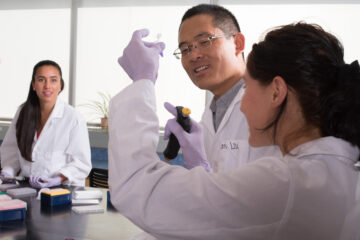At Greyhills Academy in Tuba City, STEM students help chart their own course

On a recent weekday morning, I logged on to a zoom session of Mrs. Mathew’s summer science class at Greyhills Academy High School in Tuba City. A picture of two giant heaps of soil appeared on the screen, and then an image of Grand Prismatic Spring in Yellowstone National Park.
Volunteers from the Institute for Tribal Environmental Professionals and the Center for Ecosystem Science and Society (Ecoss) at Northern Arizona University were visiting the class to talk about extremophiles — microbes that thrive in harsh conditions.
“Why are heat-loving bacteria important for compost piles?” Ecoss volunteer Pete Chuckran asked. “Feel free to annotate an answer.”
A few seconds passed. Then, in that miracle that has become commonplace since many of us moved our lives to Zoom, typing appeared on the slide: It’s beneficial to have different kinds of specialists in the compost, a student named Braiden Lynch suggested, rather than to have bacteria that all do their decomposing work under identical conditions.
“Great answer,” Chuckran said. Others chimed in in the chat. “Nice!” From her Zoom box, teacher Reny Mathew smiled.
The session was part of a STEM (Science Technology Engineering Math) summer enrichment program at Greyhills, where Mathew has been teaching and promoting STEM education for 13 years. This summer, her class is working virtually with the NAU engineers and scientists on a range of topics, including air quality monitoring, composting, soil analysis and coding.
This course is part of what Mathew calls her “homegrown STEM program,” which includes afterschool and summer programming, internships, and opportunities for students to present their research at science fairs on the Navajo Nation and in the wider region.
“The program is challenging,” Mathew said. “It takes a lot of their after-school time. But how much time do I have? Just these four years.”
The students’ commitment is evident: many of those enrolled in her STEM program work on the same research topic across multiple years, and are selected for competitive summer internships through the Native American Science and Engineering Program, the Indigenous Summer Enhancement Program at Dine College and elsewhere. Her students have received the Chief Manuelito Scholarship, a prestigious Navajo Nation award for undergraduate education, and prizes at the Arizona Science and Engineering Fair.
This year, four of Mrs. Mathew’s students presented at the state-level science fair: Sykora Chief (the antimicrobial properties of sage), Maria Bizahaloni (soil properties across an elevation gradient from Page to Flagstaff), and Marina and Beatriz Rodriguez, who demonstrated that low-cost, indoor air filters made of natural charcoal can be used to remove wood-stove associated pollution in homes. The Rodriguez team took second place in the environmental engineering division.
“I have developed countless skills during my time in Mrs. Mathew’s STEM program,” said Marina Rodriguez, who graduated as Greyhills salutatorian this year. “Besides learning about different science topics, I have been able to increase my communication skills, writing skills, and analytical-thinking skills. The STEM program has given me the opportunity to experience the professional scientific world while still in my high school years.”
Introducing the students to professional scientists and science skills has been a primary goal for Ayla Martinez, a graduate student at Ecoss who coordinated the team’s efforts. Martinez, who was born in Nogales, said coming from a border town influenced how she came to science, and the research questions she asks now: “I wanted to help students access the kinds of opportunities and tools that helped me choose a career in biology.”
When the pandemic forced remote instruction in 2020, Mrs. Mathew’s class faced extra challenges: reliable internet can be inconsistent or hard to access on the vast Navajo Nation. But Mathew said her students persisted and stayed engaged. Through the partnership with ITEP’s Environmental Education Outreach Program, coordinated by Julaire Scott, they received science kits to learn from home about composting and air quality.
“Since we typically hold outreach sessions in person with hands on activities, it was a learning curve for us to make the presentations as engaging as possible,” Scott said. She was impressed with the students’ final presentations and how they synthesized the online lessons.
The pandemic also provided a real-world opportunity to discuss the importance of reliable sources, Martinez said. “We were deep into the pandemic, and all this information was out there about COVID,” she said. “We wanted to give power to these students by making sure they knew how to identify reliable sources of information — in their research and in the news.”
Rodriguez said the reliable source seminars were helpful and provided her resources such as databases where she can verify information in the future. “They introduced me to the importance of finding the truth and using it in my scientific research.”
Jeff Propster, one of the team members, appreciates how Mathew invites her students to shape the after-school curriculum. “The group was close enough and we were flexible enough to tailor our help to what they wanted to learn,” he said.
This spring, the students asked the NAU team to act as an audience as they practiced their presentations for the Arizona Science and Engineering Fair in April.
Mathew is proud of how Greyhills students have become a fixture at the state science fair: “I see very few Navajo students there, but we are always there.”
Martinez agreed that representation is critical as students learn about potential career paths. As many in the sciences grapple with racism and other structural barriers that have led to a lack of diversity and equity in research, Martinez said her team’s collaboration with ITEP and Greyhills is a small step toward a more inclusive research community.
“It’s important that we help show that anyone can be part of STEM,” she said.
The team from Ecoss is also offering an introduction to coding in the programming language R this summer and plans to offer sessions again in the fall.
“The sophistication of their research questions is so impressive to me,” Propster said. “In a year where there were all these hurdles, it was really inspiring that these kids were willing to meet after school — on the internet again — to do science.”
Mansel Nelson, director of the ITEP Environmental Education Outreach Program, has worked with Mathew’s science classes for several years and helped connect her with NAU researchers, including the Ecoss team and professor Jani Ingram, who researches environmental contaminants and their health impacts.
“Reny provides opportunities for her students beyond the typical classroom,” Nelson said.
“It’s not just doing a little experiment,” Mathew said. “It’s about learning how to do extensive research and learning to communicate that. It’s challenging. But it will bring the best out of them. That is what I have seen.”


